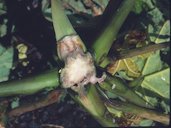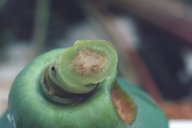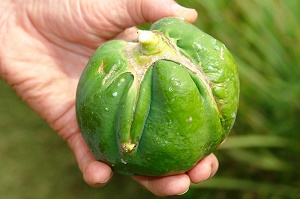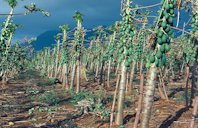| Papaya Injuries and Other Symptoms | ||||||||||||||||||||||||||||||
|---|---|---|---|---|---|---|---|---|---|---|---|---|---|---|---|---|---|---|---|---|---|---|---|---|---|---|---|---|---|---|
| Back to Papaya Page 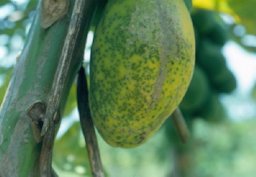 Fig. 1 Freckles on papaya 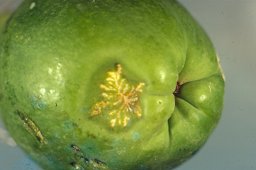 Fig. 2  Lightning injury 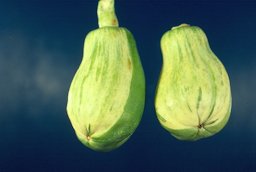 Fig. 8  Variegation of papaya (Carica papaya), a non-pathogenic physiological disorder or mutation. 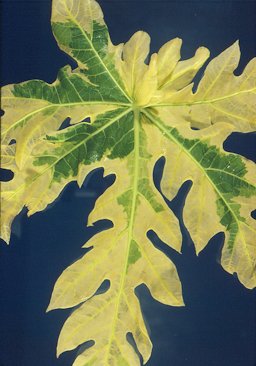 Fig. 9  Variegation of papaya (Carica papaya), a non-pathogenic physiological disorder or mutation.  Fig. 10  Cockroach damage to stem 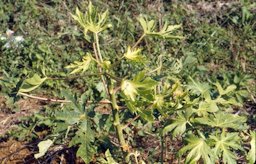 Fig. 11  Herbicide damage 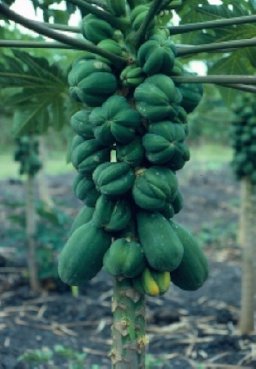 Fig. 12 Carpellody or "cat-face" fruits 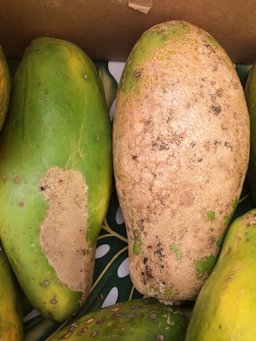 Fig. 21  Such scarring of papaya fruits could result from one or more of several different causes, including spider mites feeding injury, sun scald, or pesticide spray injury and/or phytotoxicity. The expression of symptoms may also be papaya-variety dependent.
|
Freckles Non-pathogenic Disorder (Fig.1) Freckles are initially noticed as small pinpoint spots on fruits that are half developed. As the fruit matures the spots slowly increase in size up to about 13 mm in diameter. However, the spots usually do not increase beyond 4 mm in diameter. The spots are brown in color, have a reticulated pattern, and may have a water-soaked margin. The centers of large spots may attain a grayish color. Freckles are usually limited to the exposed surface of the fruit facing away from the stem. They occur throughout the year but appear to be more prevalent during seasons or periods when sunny days prevail. Freckles are superficial and do not affect the flesh and are, therefore, primarily a cosmetic disorder. Fruits that are covered with pollination bags soon after formed remain free of freckles at harvest. 1 Lightning Injuries
Fig. 2. A group of adjacent papaya plants with wilt symptoms suffering from lighting injury Fig. 3. Lightning injury (internal necrosis) to papaya stem Fig. 4. Black necrosis of internal papaya stem caused by high temperatures associated with lighting injury Fig. 5. Internal burn of fruit pedicel Fig. 6. Blackened papaya stem after being struck by lightning Fig. 7. Sunken, necrotic spot in papaya fruit indicates where a lightning bolt probably penetrated Further Reading Lightning Injury to Plants, University of Hawai'ii pdf Catface or Carpellody "Cat face" or carpellody is specific to papaya. The appearance of carpellodic fruits can range from those that resemble female fruits to those that are severely deformed with longitudinal ridges or seams. Carpellodic fruits are generally rounded rather than the more typical pyriform shape and are unmarketable. Carpellody or "cat-face" fruits result when stamens develop abnormally into carpel-like fleshy structures. Sex expression in hermaphroditic papaya trees is variable and is influenced by environmental factors. The development of carpellodic fruits is favored by low night temperatures in combination with high moisture and nitrogen levels. Carpellody is an inherited trait thus careful seed selection can reduce its occurrence. 2
Fig. 13. Carpellody of papaya fruit, a physiological disorder (not pathogenic) Fig. 14. Catface (carpellody) of papaya: physiological disorder Other Types of Injuries
Fig. 15. Hurricane damage to papaya Fig. 16. Boron deficiency of papaya Fig. 17. Boron deficiency of papaya: lumpy fruits Fig. 18. Birds feeding injury to fruit Fig. 19. Latexosis Fig. 20. Iron (Fe) deficiency Further Reading Boron Deficiency in Papaya, University of Hawai'i pdf |
|||||||||||||||||||||||||||||
| Bibliography 1 Nishijima, Wayne. "Freckles on Papaya." Knowlegde Master, Extension Entomology & University of Hawai'i CTAHR Integrated Pest Management Program, Jan. 1993, extento.hawaii.edu. Accessed 11 Apr. 2014. 2 Nishijima, Wayne. "Carpellodyor Cat Face, papaya." Knowlegde Master, Extension Entomology & University of Hawai'i CTAHR Integrated Pest Management Program, Jan. 1993, extento.hawaii.edu. Accessed 11 Apr. 2014. Photographs Fig. 1,2,3,4,5,6,7,8,9,10,11,12 Nelson, Scot C. "Papaya (Carica papaya)." Pest and Disease Image Gallery, (CC BY-SA 2.0), hawaiiplantdiseases.net. Accessed 11 Apr. 2014. Fig. 13 "Carpellody of papaya fruit, a physiological disorder (not pathogenic)." Pest and Disease Image Gallery, University of Hawai'i, 2006, (CC BY-SA 2.0), flickr.com. Accessed 20 Feb. 2017. Fig. 14 Nelson, Scot C. "Catface (carpellody) of papaya: physiological disorder." Pest and Disease Image Gallery, University of Hawai'i, 2007, (CC BY-SA 2.0), flickr.com. Accessed 19 Fev. 2017. Fig. 15 Nelson, Scot C. "Hurricane damage to papaya (Carica papaya)." Pest and Disease Image Gallery, University of Hawai'i, 2011, (CC BY-SA 2.0), flickr.com. Accessed 19 Fev. 2017. Fig. 16,17 "Boron deficiency of papaya (Carica papaya)." Pest and Disease Image Gallery, University of Hawai'i, 2011, (CC BY-SA 2.0), flickr.com. Accessed 20 Feb. 2017. Fig. 18,19,20 "Papaya: Birds feeding injury to fruit." Pest and Disease Image Gallery, University of Hawai'i, 2016, (CC BY-SA 2.0), flickr.com. Accessed 20 Feb. 2017. Fig. 21 "Papaya: Iron (Fe) deficiency." Pest and Disease Image Gallery, University of Hawai'i, 2014, (CC BY-SA 2.0), flickr.com. Accessed 20 Feb. 2017. Published Jan. 2014 LR. Last update 19 Feb. 2017 LR |
||||||||||||||||||||||||||||||

